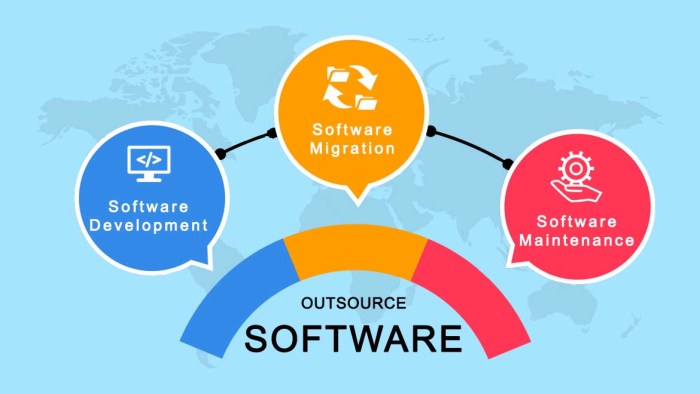Software development outsourcing & support services – In today’s dynamic business environment, leveraging external expertise has become a strategic imperative. Software development outsourcing and support services offer businesses of all sizes the opportunity to access skilled talent, reduce costs, and accelerate time-to-market. This comprehensive guide delves into the intricacies of outsourcing software development, exploring its benefits, challenges, and best practices. We’ll cover everything from choosing the right outsourcing partner to managing the ongoing support and maintenance of your software.
Understanding Software Development Outsourcing
Software development outsourcing involves contracting a third-party company or individual to handle all or part of your software development project. This can range from designing and developing a complete application to providing specific services like testing, maintenance, or support. The outsourcing model offers significant flexibility, allowing businesses to scale their development teams up or down as needed, access specialized skills, and focus on core competencies.
Types of Software Development Outsourcing, Software development outsourcing & support services
- Onshore Outsourcing: Hiring a company within the same country.
- Nearshore Outsourcing: Hiring a company in a geographically close country.
- Offshore Outsourcing: Hiring a company in a geographically distant country.
- Project-Based Outsourcing: Outsourcing a specific project with a defined scope and timeline.
- Dedicated Team Outsourcing: Hiring a dedicated team of developers who work exclusively on your projects.
Benefits of Outsourcing Software Development
Outsourcing offers a multitude of advantages, significantly impacting a company’s bottom line and operational efficiency. Key benefits include:
- Cost Reduction: Accessing lower labor costs, particularly when outsourcing to countries with lower average salaries.
- Access to Specialized Skills: Tap into a global talent pool with expertise in niche technologies and languages.
- Faster Time-to-Market: Leverage larger teams and parallel development processes to accelerate project delivery.
- Increased Focus on Core Business: Free up internal resources to concentrate on strategic initiatives and core business functions.
- Scalability and Flexibility: Easily scale your development team up or down based on project demands.
- 24/7 Support: Utilize time zone differences to ensure continuous development and support.
Challenges of Software Development Outsourcing
While outsourcing presents numerous benefits, it’s crucial to acknowledge potential challenges:
- Communication Barriers: Language differences and cultural nuances can hinder effective communication.
- Time Zone Differences: Coordinating work across different time zones can be complex.
- Quality Control: Ensuring consistent quality of work requires robust quality assurance processes.
- Security Concerns: Protecting intellectual property and sensitive data is paramount.
- Finding the Right Partner: Selecting a reliable and competent outsourcing partner requires thorough due diligence.
- Managing the Relationship: Effective communication and collaboration are crucial for successful outsourcing.
Choosing the Right Outsourcing Partner
Selecting the right outsourcing partner is critical for project success. Consider these factors:
- Experience and Expertise: Look for a partner with a proven track record and relevant experience in your industry.
- Technology Stack: Ensure the partner possesses expertise in the technologies you require.
- Communication and Collaboration: Evaluate their communication processes and responsiveness.
- Security Measures: Assess their security protocols and data protection measures.
- References and Testimonials: Check references and testimonials from previous clients.
- Contractual Agreements: Carefully review the contract to ensure clear terms and conditions.
Software Development Outsourcing Support Services
Ongoing support and maintenance are crucial for the long-term success of any software project. Outsourcing providers typically offer a range of support services, including:

Source: clockwise.software
- Bug Fixes and Patches: Addressing bugs and vulnerabilities to ensure software stability.
- Technical Support: Providing assistance to users experiencing technical issues.
- Maintenance and Updates: Regularly updating the software to address security vulnerabilities and add new features.
- Performance Monitoring: Tracking software performance and identifying areas for improvement.
- System Administration: Managing the server infrastructure and ensuring optimal performance.
Best Practices for Software Development Outsourcing
To maximize the benefits of outsourcing, follow these best practices:
- Clearly Define Requirements: Develop detailed specifications and documentation.
- Establish Clear Communication Channels: Implement regular communication and progress reporting.
- Use a Robust Project Management Methodology: Employ Agile or Waterfall methodologies to manage the project effectively.
- Implement Quality Assurance Processes: Establish rigorous testing and quality control procedures.
- Build Strong Relationships: Foster a collaborative relationship with your outsourcing partner.
- Regularly Review Performance: Monitor the progress and performance of your outsourcing partner.
Frequently Asked Questions (FAQ)
- Q: How much does software development outsourcing cost? A: Costs vary greatly depending on factors like project scope, complexity, location, and the outsourcing provider’s rates.
- Q: How do I choose the right outsourcing model? A: The best model depends on your specific needs and project requirements. Consider factors like budget, timeline, and required expertise.
- Q: What are the risks of outsourcing software development? A: Risks include communication challenges, quality control issues, security concerns, and intellectual property protection.
- Q: How can I mitigate the risks of outsourcing? A: Mitigate risks by carefully selecting a partner, establishing clear communication channels, implementing robust quality assurance processes, and having a well-defined contract.
- Q: What is the difference between nearshore and offshore outsourcing? A: Nearshore outsourcing involves hiring a company in a geographically close country, while offshore outsourcing involves hiring a company in a geographically distant country.
Conclusion
Software development outsourcing offers a powerful way for businesses to access talent, reduce costs, and accelerate innovation. By understanding the benefits, challenges, and best practices Artikeld in this guide, you can make informed decisions and leverage the power of outsourcing to achieve your software development goals. Remember thorough planning, clear communication, and a well-chosen partner are key to a successful outsourcing experience.
References: Software Development Outsourcing & Support Services
- Gartner (for market research and insights)
- Forbes (for business and technology articles)
- Accenture (for outsourcing services and consulting)
Call to Action
Ready to explore the benefits of software development outsourcing? Contact us today for a free consultation and let us help you find the perfect outsourcing partner for your next project!
Questions Often Asked
What are the common risks associated with software development outsourcing?

Source: systemart.com
Common risks include communication barriers, intellectual property concerns, quality control challenges, and potential time zone differences impacting collaboration.
How do I choose a reputable software development outsourcing partner?
Thorough research is key. Look for companies with proven track records, strong client testimonials, clear communication processes, and a well-defined project management methodology.
What is the typical cost structure for software development outsourcing?
Costs vary greatly depending on factors like project complexity, team size, location of the outsourcing partner, and the specific services required. Fixed-price contracts and time-and-materials models are common approaches.
How can I ensure effective communication with my outsourcing team?

Source: eleks.com
Establish clear communication protocols from the outset, utilizing tools like project management software, regular video conferencing, and well-defined reporting mechanisms.
